Comparative Report on Social Innovation across Europe
Alessandro DESERTI, Maria KLEVERBECK, Tamami KOMATSU, Francesca RIZZO & Judith TERSTRIEP
|
In mid-August the comparative report on social innovation was delivered. It includes the empirical findings of SIMPACT project elicited from the analysis and discussion of the Business Case Studies, the Social Innovation Biographies and the theoretical framework defined in the previous months. More specifically, based on the common understanding of economic principles, objectives & components related to social innovation a first categorisation of factors and concepts affecting social innovation trajectories was firstly elaborated. Subject to an iterative process of theorising and evidence collection, the theoretically deduced categories and related hypotheses required empirical verification. SIMPACT's overall research programme is directed towards establishing strong synergies between the production of theory, strategy and appropriate methodologies. In this vein, the evolutionary character of social innovations and the dynamics of related policy streams are reflected in the distinct forms and various levels of analysis:
|
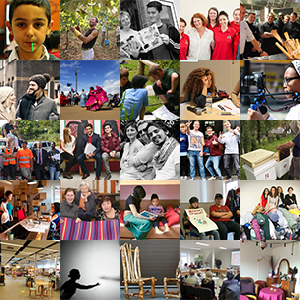
|
||
Social Innovation Components - Institutions, Actors & Resources
|
Distribution of Cases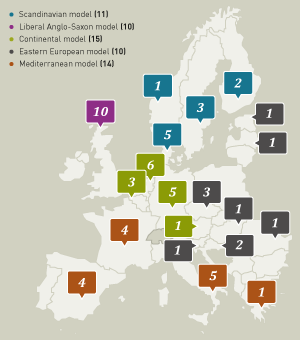
Our UnderstandingComponents comprise the institutional context plus actors and resources as central production factors. |
||
Social Innovators' Social, Economic & Political Objectives
|
Our UnderstandingMicro and meso-level objectives refer to the goals and underlying motivations of actors or organisations to engage in social innovation. These objectives can be social in nature or cover social and economic goals. 
|
||
Social Innovation Principles
|
Effectiveness & Efficiency, Business Models & GovernanceSocial innovation principles refer to concepts or strategies for efficient allocation of resources in reference to the set objectives, modes of efficiency and governance. 
|
2nd Stakeholder Experiment
Feedback from the Layer of Practice
Bastian PELKA
|
SIMPACT held it's second stakeholder involvement workshop on 25th June 2015 at CEPS office, Brussels. 12 external experts representing social entrepreneurs, social policy, welfare institutions and networks of vulnerable people, came together in a one day workshop, facilitated by TUDO researchers Bastian PELKA and Eva WASCHER. «SIMPACT is building on rich data on social innovation», Bastian PELKA said. «But with our aim of providing practical tools and concepts for underpinning social innovation, we want to undergo our research a continuous 'reality check'», he adds. And this is where the smallscale stakeholder experiments come into play: Once per year TUDO is facilitating a workshop with external stakeholders to discuss SIMPACT's preliminary research findings with the layer of practice. These workshops are facilitated as «experiments», as it is the purpose of the workshops to confront the research findings with external ? and critical ? views. It is the aim of this task «(...) to contrast the modelling exercise with qualitative feedback from policy makers, intermediaries - representing the identified vulnerable groups - and innovators.» (SIMPACT Description of Work, 9). The smallscale stakeholder experiments aim at qualitative feedback from the perspective of all quadruple helix partners on Social Innovation. These are stakeholders who are either
|
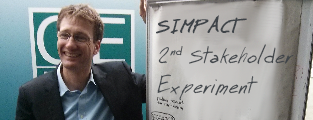
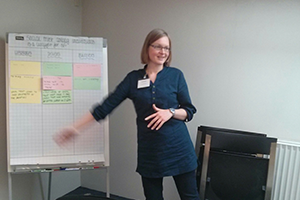
|
|
|
TUDO collected central theses from all running research activities within SIMPACT and the 2nd stakeholder workshop was experimenting with these theses. The following statements exemplify the feedback received:
|
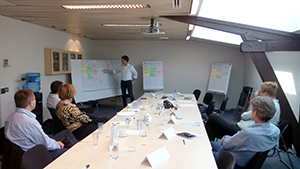
|
ESSE - SUMMER SCHOOL ON SOCIAL ECONOMY:
Personalisation and Social Entrepreneurship
Francesca RIZZO
|
On 10th July 2015 Simpact European research project organized one full day of the EUROPEAN SUMMER SCHOOL ON SOCIAL ECONOMY (ESSE) held in Bertinoro (FC), Italy, by the University of Bologna and Aiccon association in partnership with EMES Network, Euricse and the Social Economy and Civil Society Integrated Research Team of Bologna University. The summer school focused on «Personalisation and Social Entrepreneurship» and included 23 participants of which 18 students (students, PhDs and researchers) and 5 practitioners mostly coming from Europe (67%) but also from Asia (12%), Middle-East (13%) and America (8%). The morning session included two lessons on the economic underpinning of social innovation and on SI ecosystems, presenting the two EU projects SIMPACT and SI-Drive. SIMPACT project coordinator Judith TERSTRIEP from IAT opened the session framing the context. She presented the main global challenges that need to find new responses, such as health related issues, demographic change and wellbeing, climate change, the liberalization of the economic systems and the ways societies are reacting to them. She completed the introduction by providing the participants with concrete numbers on poverty, unemployment and especially youth current condition across Europe, that appears to be one of the main challenges at EU level. She then explained social innovation using already existing definitions from different authors and highlighted the changing perspective to get to the Simpact project definition focusing on «empowering and (re-)engaging vulnerable groups in society either through the innovation process or as a result of it». Indeed SIMPACT proposes a mind-shift from «vulnerable as burden of society» towards «vulnerable as untapped potential for society». Judith deeply presented SIMPACT explaining the concept, from roots to results, and focusing on the work already done regarding Middle Range Theorising and Evidence-based Knowledge. A significant part of the talk was dedicated to the methodology used for collecting the evidences through the Business Case Studies and the Social Innovation Biographies including desk and field research and the process of triangulation of the achieved insights. She then concluded presenting the results from the comparative analysis and an extract of the findings related to the theoretical model: |
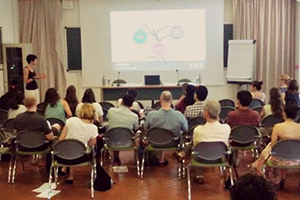
Components, Objectives & Principles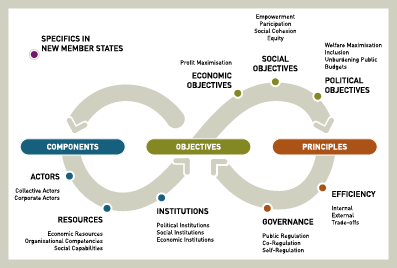
|
|
|
Christoph KALETKA from TU Dortmund University presented some reflections on SI ecosystems driven from SI-Drive. He started by defining SI ecosystems as the interplay of resources, environmental conditions and «... a set of complex, interdependent relationships that function best through effective networks and communities» (Pulford 2011, 113). Then he introduced the three project main objectives:
Christoph's lessons focused on the full understanding of the main social innovation intermediaries commonly called SI Labs, Hubs or Centres. He pointed out the existence of four categories of Labs based on the actor they serve. Other possible classification were taken into account such as the problems addressed, named as complex problems, with different actors, disciplines, sectors involvement; adaptive problems, changing due to actors adjusting their behaviour; problems for which there is no clear responsibility / accountability. The presentation concluded by presenting two case studies on the Toronto and Tilbourg Centres/Labs to provide a concrete example of such form of SI intermediaries. In the end of the morning an open discussion on the SIMPACT project evidences was facilitated by Alessandro Deserti from Politecnico di Milano. While the afternoon session was entirely dedicated to the students groups that worked on the reverse engineering of SIMPACT's case studies to draw their business models. |
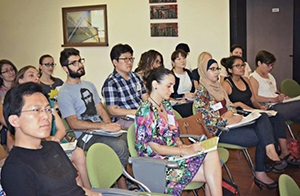
Distinct Labs
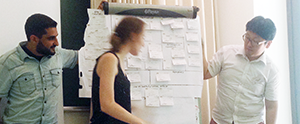
|
SIMPACT Consortium attends the International Social Innovation Research Conference 2015
Alfonso UNCETA, Javier CASTRO SPILA, Álvaro LUNA
|
SIMPACT project partners were part of the Social Innovation Research Conference (ISIRC) 2015, which was held in York from the 6th to the 8th of September. Among these partners were members from the Westphalian University - IAT, the Neoma Business School, TNO, and Sinnergiak. Most presentations were held under the topic «Economic Underpinnings and Social Innovation», which was chaired by SIMPACT coordinator, Judith Terstriep (IAT), Alex Nicholls and Rafael Ziegler (Oxford University, CreSSI project). This topic was a strategic subject in the conference, aknowledging the importance of the different theoretical approaches towards social innovation, and its social and economic impact. In this sense, the contributions of the mentioned Simpact partners was crucial by pointing out the main challeneges we encounter when we analyse social innovation initiatives and try to measure its processes of development and implementation. This approach towards the study of social innovation was emphasized by the contirbutions of:
|

|
|
|
Another of the key topics in the conference was focused on Hybridity, Governance, and Organising Social Innovation, where Sinnergiak partners Alfonso, Unceta, Javier Castro, and Álvaro Luna presented their proposal Social Innovation Communities: Hybridity and Governace, stressing out their hybrid nature in the development and managment of their potential capacities, when facing social problems and desinging socio-innovative prototypes. |
In Short
|
The track «Rethinking Business Models for Social Innovation» organised by SIMPACT project within the SI Conference «Pathways to social change» has received a lot of attention from the conference attendees. Due to the high number of requests the organisers have decided to open it to a larger audience. Short description: Even if quite a few adaptations to social enterprises of schemes and tools meant to design business models for commercial enterprises have been tried, there is a lack of investigation and understanding of the specificity of business models for social innovation. Apart from the seminal work of Smith, Binns and Tushman (2010) and that of Jonker and Dentchev (2013), very little has been said on this topic. The session will present and discuss with participants the results of the extensive empirical research on the economic foundation of social innovation conducted in the SIMPACT project, showing how social innovation is characterised by intrinsic contradictions/dilemmas and other contextual conditions that naturally lead to the creation of complex business models, partially or substantially different from those adopted by commercial enterprises. |
Rethinking Business Models for Social Innovation
19 November 2015, 11.00-12.30 |
|
|
The UBATH team together with Judith Terstriep published a new working paper on the SIMPACTs website: Stimulating, Resourcing and Sustaining Social Innovation - Towards a New Mode of Public Policy Production and Implementation Abstract: Social innovations «meet social needs», are «good for society» and «enhance society's capacity to act». But what does their rising importance tell us about the current state of public policy in Europe and its effectiveness in achieving social and economic goals? Some might see social innovation as a critique of public intervention, filling the gaps left by years of policy failure. Others emphasise the innovative potential of cross-boundary collaboration between the public sector, the private sector, the third sector and the household. This paper explores the conditions under which the state either enables or constrains effective social innovation by transcending the boundaries between different actors. We argue that social innovation is closely linked to public sector innovation, particularly in relation to new modes of policy production and implementation, and to new forms of organisation within the state that challenge functional demarcations and role definitions. |
New SIMPACT Working Paper
Volume 2015 Issue 3 |
Upcomming Events

2015 Net Impact Conference
5-7 November 2015, Washington State Convention Center, Seattle, WA
At the 23rd Net Impact Conference in Seattle student and professional leaders will come together to tackle the world's toughest social and environmental problems. 80+ sessions span 9 different fields of interest, allowing you to dig deep in a particular topic or get an overview of an area.
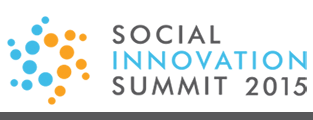
Social Innovation Summit 2015
17-18 November 2015, Silicon Valley (USA)
The Social Innovation Summit is a twice annual event taking place in Washington, DC and Silicon Valley, that represents a global convening of black swans and wayward thinkers. Where most bring together luminaries to explore the next big idea, we bring together those hungry not just to talk about the next big thing, but to build it.
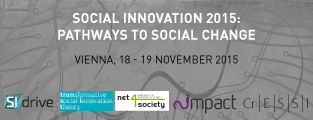
«Pathways to Social Change»
18-19 November 2015, Vienna (Austria)
«Pathways to Social Change» is planned and designed by mutually complementary research projects on social innovation that reach out to world-wide experiences and concepts of social innovation. The conference will connect researchers with policy makers and practitioners of social innovation.
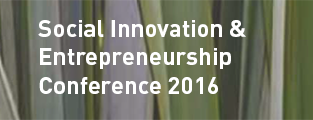
Social Innovation and Entrepreneurship Conference
10-12th February 2016, Auckland, New Zealand
The conference theme - Collaborating for Impact - reflects the importance of collaborative action for advancing this emerging scholarly field. Following on from the successful inaugural 2011 and 2013 international conferences, the 2016 conference brings together participants across sectors (non-profit, business, government sectors) and academic disciplines to advance theory, practice and policy in social innovation and social entrepreneurship.

ICSEI 2016
23-24 May 2016, London (UK)
The 18th International Conference on Social Entrepreneurship and Innovation aims to bring together academic scientists, researchers and research scholars to exchange their experiences and research results about all aspects of Social Entrepreneurship and Innovation. It also provides a forum for researchers, practitioners and educators to present and discuss the most recent innovations, trends, and concerns, practical challenges encountered and the solutions adopted.

2016 Eu-SPRI Conference
7-10 June 2016, Lund (Sweden)
The theme is «Exploring New Avenues for Innovation and Research Policies». The conference is organised by CIRCLE, Lund University. The key objectives are to enable scholars interested and active in the areas of research and innovation policy analysis to exchange views and present findings across disciplinary boundaries as well as to interact with policy-makers and politicians. The Call for Paper Abstract Proposals will be published on the website on December 15, 2015.
